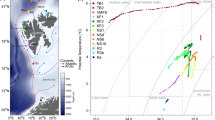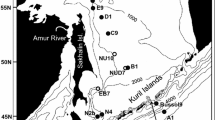Abstract
Eggs of the calanoid copepodsLabidocera wollastoni (Lubbock) andCentropages hamatus (Lilljeborg) and others, which could not be reliably assigned to species, were identified from sediment samples taken during three cruises in December 1984, January 1986, and February 1987 in the southern North Sea, the English Channel, the Irish Sea and the Celtic Sea. Eggs were most abundant in sediment samples taken between 20 and 80 m depth, with bottom stress less than 10 dyn cm−2, and near to the positions of tidal fronts. It is suggested that sedimentation, resuspension and sediment transport contribute to the causes of these distributions, which have been found to be consistent with the distributions of species which are known to produce diapause eggs as an overwintering strategy. Nauplii ofL. wollastoni, C. hamatus, C. typicus (Krøyer)Temora longicornis (Müller) andAcartia sp. hatched from incubated sediment samples. The last noted hatchings ofL. wollastoni, Centropages spp. andT. longicornis all occurred more than 1 yr after the start of the incubation experiments.
Similar content being viewed by others
Literature cited
Bowman, T. E., Abele, L. G. (1982). Classification of the recent Crustacea. In: Abele, L. G. (ed.) The biology of Crustacea. 1. Systematics, the fossil record and biogeography. Academic Press, New York, p. 1–27
Colebrook, J. M. (1982a). Continuous plankton records: seasonal variations in the distribution and abundance of plankton in the North Atlantic Ocean and the North Sea. J. Plankton Res. 4: 435–462
Colebrook, J. M. (1982b). Continuous plankton records: persistence in time-series and the population dynamics ofPseudocalanus elongatus andAcartia clausi. Mar. Biol. 66: 289–294
Colebrook, J. M. (1985). Continuous plankton records: overwintering and annual fluctuations in the abundance of zooplankton. Mar. Biol. 84: 261–265
Collins, M. B., Banner, F. T. (1980). Sediment transport by waves and tides: problems exemplified by a study of Swansea Bay, Bristol Channel. In: Banner, F. T., Collins, M. B., Massie, K. S. (eds.). The north-west European shelf seas: the sea bed in motion. 11. Physical and chemical oceanography, and physical resources. Elsevier, Amsterdam, p. 369–390
Creutzberg, F. (1984). A persistent chlorophylla maximum coinciding with an enriched benthic zone. Proc. 19th Eur. mar. Biol. Symp. 97–108 [Gibbs, P. E. (ed.) Cambridge University Press, Cambridge]
Edinburgh Oceanographic Laboratory (1973). Continuous plankton records: a plankton atlas of the north Atlantic and the North Sea. Bull. mar. Ecol. 8: 1–174
Grice, G. D., Gibson, V. R. (1982). The developmental stages of the calanoid copepodLabidocera wollastoni (Lubbock) with observations on its eggs. Cah. Biol. mar. 23: 215–225
Johnson, M. (1967). Some observations on the hatching ofTortanus discaudatus eggs subjected to low temperature. Limnol. Oceanogr. 12: 405–410
Kasahara, S., Uye, S., Onbé, T. (1975) Calanoid copepod eggs in sea-bottom muds. II. Seasonal cycles of abundance in the populations of several species of copepods and their eggs in the Inland Sea of Japan. Mar. Biol. 31: 25–29
Klein Breteler, W. C. M. (1982). The life stages of four pelagic copepods (Copepoda: Calanoida) illustrated by a series of photographs. Neth. Inst. Sea Res. Publ. Ser. 6: 1–32
Lawson, T. J., Grice, G. D. (1970). The developmental stages ofCentropages typicus Krøyer (Copepoda, Calanoida). Crustaceana 18: 182–208
Lee, A. J., Ramster, R. W. (1981). Atlas of the seas around the British Isles. Ministry of Agriculture, Fisheries and Food, Lowestoft, Surrey
Lindley, J. A. (1986). Dormant eggs of calanoid copepods in sea bed sediments of the English Channel and southern North Sea. J. Plankton Res. 8: 399–400
Lindley, J. A., Hunt, H. G. (1989). The distribution ofLabidocera wollastoni andCentropages hamatus in the north Atlantic Ocean and the North Sea in relation to the role of resting eggs in the sediment. In: Ryland, J. S., Tyler, P. A. (eds.) Reproduction, genetics and distributions of marine organisms. Olsen & Olsen, Fredensborg, p. 407–413
Marcus, N. M. (1984). Recruitment of copepod nauplii into the plankton: importance of diapause eggs and benthic processes. Mar. Ecol. Prog. Ser. 15: 47–54
Marcus, N. H., Fuller, C. M. (1989). Distribution and abundance of eggs ofLabidocera aestiva (Copepoda: Calanoida) in bottom sediments of Buzzards Bay, Massachusetts, USA. Mar. Biol. 100: 319–326
Oberg, M. (1906). Die Metamorphose der Plankton-Copepoden der Kieler Bucht. Wiss. Meersunters. (Abt. Kiel.) 9: 37–175
Pertzova, N. M. (1974). Life cycle and ecology of a thermophilous copepodCentropages hamatus in the White Sea. Zool. Zh. 53: 1013–1022
Pingree, R. D., Griffiths, D. K. (1979). Sand transport paths around the British Isles resulting from M2 and M4 tidal interactions. J. mar. biol. Ass. U.K. 59: 497–513
Reid, P. C. (1975). A regional sub-division of dinoflagellate cysts around the British Isles. New Phytol. 75: 589–603
Sazhina, L. I. (1968). On hibernating eggs of marine Calanoida. Zool. Zh. 47: 1554–1556
Smith, S. L., Lane, P. V. Z. (1987). On the life history ofCentropages typicus: responses to a full diatom bloom in the New York Bight. Mar. Biol. 95: 305–313
Soulsby, R. L. (1983). The bottom boundary layers of shelf seas. In: Johns, B. (ed.). Physical oceanography of coastal and shelf seas. Elsevier, Amsterdam, p. 189–266
Stride, A. H. (1973). Sediment transport by the North Sea. In: Goldberg, E. D. (ed.). North Sea Science. M.I.T. Press, Cambridge, Mass., p. 101–150
Uye, S. (1985). Resting egg production as a life history strategy of marine planktonic copepods. Bull. mar. Sci. 37: 440–449
Wall, D., Evitt, W. R. (1975). A comparison of the modern genusCeratium Salwark, 1793, with certain Cretaceous marine dinoflagellates. Micropaleontology 21: 14–44
Warwick, R. M., Collins, N. R., Gee, J. M., George, C. L. (1986). Species size distributions in benthic and pelagic metazoa: evidence for interaction. Mar. Ecol. Prog. Ser. 34: 63–68
Author information
Authors and Affiliations
Additional information
Communicated by J. Mauchline, Oban
Rights and permissions
About this article
Cite this article
Lindley, J.A. Distribution of overwintering calanoid copepod eggs in sea-bed sediments around southern Britain. Mar. Biol. 104, 209–217 (1990). https://doi.org/10.1007/BF01313260
Accepted:
Issue Date:
DOI: https://doi.org/10.1007/BF01313260




